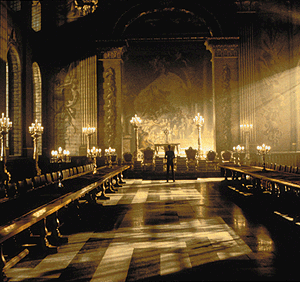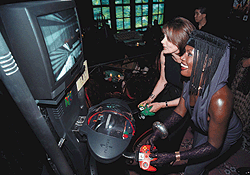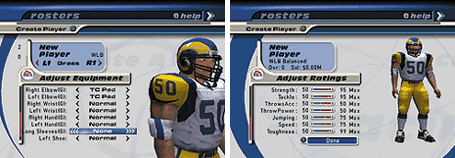Jacquie Kubin delves into gaming. From its history to its future, she discusses the brink that gaming is getting ready to leap, and yes, film industry, you should be looking over your shoulder...

"The new generation of video game consoles are more than just game players," explains Doug Lowenstein, President of the Interactive Digital Software Association. "They have the potential to become the center of the home entertainment universe, rolling games, Internet access and DVD movies into a single set top unit at an affordable price."
Whether they are learning from their children or from the media, general consumers are becoming more aware of game consoles as an entertainment option. According to PC Data, located in Reston, Virginia, one out of three home Internet users plans to purchase one of the next generation game consoles. The reported leading preference at the time of study (June, 2000) was the Playstation 2 with the Sega Dreamcast receiving 22.4%, Nintendo Game Cube 17.2% and X-Box 11.9% of consumer loyalty. Out of 1,500 persons surveyed, the propelling interest for 75% of respondents was the lure of online gaming.
View distribution statistics of video game software market share by game console (10-15-00). Information courtesy of PC Data.
"The social aspect of this medium is going to cause the most dramatic change with the biggest zeitgeist being the ability for players to partake in multi-player story worlds," says Celia Pearce, Research Associate, Annenberg Center for Communication, University of Southern California (www.annenberg.edu). "Consider that television watchers will have the option of either watching sitcom re-runs or joining in on an engaging, fun game with family or friends who are living in other areas of the world. When that becomes available on the television set for less than $300 there is going to be a major consumer conversion."
The new game consoles will also be changing the game development community comprised of both first party, those groups owned and directed by the game console manufacturer, and third party, independent groups who create games for console play, developers.
Video gaming is changing, but how broad its future success is will surely hinge on its ability to be all things to all people. Or at least offer something to each member of the family.
View Playstation 2 console specifications. © Sony Computer Entertainment America Inc. All rights reserved.. View Nintendo Game Cube console specifications. © Nintendo of America, Inc. All rights reserved. View Sega Dreamcast console specifications. © Sega Corporation. View Microsoft X-box console specifications. © Microsoft Corporation. All rights reserved.
 All-Star Kobe Bryant, left, plays the self-titled basketball video game Kobe Bryant in NBA Courtside. Photo courtesy of Newscom.com, Feature Photo Service.
All-Star Kobe Bryant, left, plays the self-titled basketball video game Kobe Bryant in NBA Courtside. Photo courtesy of Newscom.com, Feature Photo Service.
And Then There Were Four
Through the ups and downs of the game industry, game system consoles have come and gone.
Pre-historic systems, the Atari, Mattel's Intellivision, Coleco Industries Colecovision and Magnavox's Odyssey 2 had all but disappeared when Nintendo of Japan entered into the fray releasing the Nintendo Entertainment System (NES) in 1985.
The 8-bit NES revitalized a home gaming market that had grown lackluster because of the limitations of game play. With an 8-bit machine that worked at a speed of 1.70 MHz and was capable of displaying 16 colors at one time, developers began to see new creative opportunities. But the quest was on to make a better gaming system that allowed game developers more opportunity to create experiences that would hold gamer loyalty.
The next step came with the release of the first 16-bit systems, the Sega Genesis and the Super Nintendo Entertainment System (SNES), until the industry exploded once again when the new machines, the Sega Saturn, Nintendo 64 and Sony Playstation were released in the mid 1990s.

And though other developers tried to introduce new platforms, including the Apple Pippin and 3DO, the N64, Saturn and Playstation emerged as the dominant platforms vying for consumer loyalty while enticing game developers to create properties that could become franchise hits for them.
Fast forward to the 1999 release of the Sega Dreamcast, the first step on the road to the 128-bit game featuring a game console so powerful that it provided enhanced characterizations with movie-like visual and audio components.
For holiday 2000, Sony created an unfulfilled consumer demand with the Playstation 2, a system that allows game players to operate Sony's library collections of more than 800 games developed for Playstation (1) and that also serves as a DVD movie player. Playstation 2 also featured a 128-bit 'emotion chip' processor that promises superior game play.

"As a gamer, I wanted the immediate gratification of the Dreamcast as did almost 4 million other gamers, which is a huge number of consoles for Sega to have sold," says Ken Soohoo, President and CEO Planetweb. "On the other hand, I also want the Playstation 2 because it gives me a lot of bang for the buck in that I can play my existing library of Playstation games on it and I get the DVD player. So while there are not a lot of new Playstation 2 games that are taking advantage of the technology yet, it is a purchase for the future that I want to have."

Not expected to be on retailer shelves until this fall, Nintendo plans to follow up the N64 with the Game Cube console, which will interact with the Game Boy Advance hand held system. Though little data is available for the Game Cube, it is reported to be using an IBM Gekko processor as its microprocessor unit, which will integrate the power of a PC central processing unit into a custom, game-centric chip. The theory behind this being that it will be easier for game developers to create games for this system, enlarging the number of third party developers creating software for the console, helping Nintendo to gain a large piece of console and software sales.
"The key factor that will separate the systems is the level of engaging, challenging and amusing software (games) that are offered," says Perrin Kaplan, director of corporate affairs, Nintendo of America. "Nintendo's 'next-gen' library for both the GameCube and Game Boy Advanced will be built with solid, challenging titles. Pokémon is a classic example of this."

The biggest tilt to the console wars may be Microsoft's proposed fall release of the X-Box. New to the game console business, but with years of consumer PC applications behind them, Microsoft is releasing a system with a streamlined architecture based on Direct X 8.0, allowing designers to create on a platform specifically designed to make development and coding as straightforward as possible.
The Microsoft X-Box has been busy forging relationships with developers including Oddworld Inhabitants, creators of Abe's Oddworld, Oddworld: Abe's Exoddus, designed for the Playstation, and now for the X-Box, Munch's Oddyssey.
After many months of development, the company switched platforms from the Playstation 2 to the X-Box. "We have chosen to develop games for the X-Box because it's clearly the most powerful console with the technology and raw horsepower needed to take the Oddworld franchise to the next level," says Lorne Lanning, Oddworld president and co-founder. "It has the most friendly development environment and points toward a future of standardization which is a tremendous breath of fresh air for the console industry."
With Great Power, Comes Great Responsibility
Since 1994 the video gaming industry has released in excess of 7,000 individual titles that are as varied as the movies released by Hollywood each year. And the number of titles will grow exponentially with the new systems.
 Celia Pearce, research associate for the USC Annenberg Center for Communication and Interactive Track Head of Production for the USC School of Cinema-Television. Photo courtesy of Celia Pearce.
Celia Pearce, research associate for the USC Annenberg Center for Communication and Interactive Track Head of Production for the USC School of Cinema-Television. Photo courtesy of Celia Pearce.
The difference in the games is that they will now be a part of a broader entertainment choice, more of an end to end experience that will deliver quality interactive content to the consumer. But without intelligent, engaging games to play the game console will not find its way to the family living room coffee table.
"The console systems have moved toward offering more than just game play content thus insuring their positions as a family entertainment option," explains Kevin Sullivan, VP Sales and Marketing, AgeTec, Inc. "But, the console will reside in the living room and the game development company must strive to offer games that contain taste, style and content that the whole family can enjoy."
Developers are being given the ability to create games that are visually, and audibly, superior through consoles with remarkable computer power. With that ability, the game developers should be looking at an audience that is expanding beyond the typical gamer who is often characterized as an 18-35 year old adolescent male.
"The biggest driving force behind acceptance of the networked console will be bringing women, and families, to the platform," Pearce says. "And that will happen when games with content for women, children and families to play together becomes more readily available."
Presently the vidgame industry does offer great diversification. Of the more than 215 million video games sold in 1999, Pokémon titles for Nintendo sold more than 12 million copies alone, though the year's biggest title was Donkey Kong 64, selling 1.4 million games for a reported $86.4 million.

Third party developer, Acclaim Entertainment, Inc. has created a diverse series of family titles from Allstar Baseball to Mary Kate and Ashley Olson adventure titles. Electronic Arts, Inc. develops games with instantly recognizable celebrity titles like John Madden NFL and Tiger Woods PGA Tour 2000/2001.
The clear victor in both software and hardware sales, however, for year 2000 was Playstation who remained victorious with 49.3 percent of overall software revenue and 50.9 percent of video game software unit sales.
Nintendo 64 captured 36 percent of software revenue and 24.9 percent of video game software unit sales.
The gaming industry's best hope for living room acceptance may well lie in being able to lure consumers to the game community where they will pay to partake in live, multi-player games instead of watching network or cable television reruns.
This will make gaming a direct competitive force against Hollywood's silver and television screens as interactive vidgames strive to eclipse the passive viewing of movies and sit-coms as one of consumer's leading entertainment choices.

Gaming Versus Hollywood
For 1999, the gap between box office receipts and VGI sales has narrowed to a scant $1.3 billion when comparing Hollywood's 1999 gross box office receipts of $7.4 billion and the VGI's industry sales of $6.1 billion.
"Over the last five years, video games have been the fastest growing segment of the entertainment industry," says Lowenstein. "Between 1995-1999 alone, sales grew more than 100%, from $3 billion to $6 billion. All signals point to annualized average growths over the next five years of 15-20%."
Harrison Ford as Indiana Jones was the quintessential explorer, thrill seeker and risk taker and a huge movie franchise for Paramount Pictures. The studio may be replacing Indy with a new tough-as-nails action hero when they release Tomb Raider later this year starring Angelina Jolie as the video game inspired femme fatale, Lara Croft.
As a franchise, Tomb Raider got its start in 1994 when game developer Eidos Interactive released her onto un-expecting male gamers everywhere. The dainty heroine was an instant success and her game life has already been sequeled three times with Tomb Raider II, Tomb Raider III: Adventures of Lara Croft and Tomb Raider: The Last Revelation. Through these action/adventure games, players have helped her to climb over, swim under and tunnel through natural and unnatural obstacles and deathtraps in her quest for treasure.
And one would have to believe that Paramount expects Lara and Angelina to be as successful a franchise as Indy and Harrison was for them. They have already signed the star for two additional Lara Croft theatrical release movies.

But this is a two way entertainment street. Major studios, such as Disney, Universal and Fox have all developed divisions that oversee the development, marketing and promotion of movie branded games. Other movie studio owned properties, such as the Warner Bros. Looney Tunes, are turned into vidgames by third party developers like Infograms Entertainment, which has also turned hot television properties like Dragonball Z to the interactive game world.
As gaming gains ground on Hollywood, the demand for quality game developers will increase, as will the need for talented producers, directors, storywriters, script developers and animators.
With new game consoles will come new games and consumers can expect to see hundreds of new titles over the coming years giving the animator many more career path options within an opportunity filled industry. An industry which is attractive to many because of the perception that it is an industry that inspires individual creativity while lacking some of the traditional, often frustrating, Hollywood baggage.
"The game entertainment expansion simply gives animators many more options throughout their career paths," says Oddworld's Lanning. "Not that long ago, if you were an animator you either worked on Saturday morning shows or you worked on feature films. Game animation has greatly expanded the traditional industries, creating an entire new industry of opportunity."

 After many months of development, the Oddworld franchise switched platforms from the Playstation 2 to the X-Box. © Oddworld Inhabitants.Top selling console game, Tony Hawke Pro Skater 2. © Activision, Inc. All rights reserved.
After many months of development, the Oddworld franchise switched platforms from the Playstation 2 to the X-Box. © Oddworld Inhabitants.Top selling console game, Tony Hawke Pro Skater 2. © Activision, Inc. All rights reserved.
One thing that stays consistent from genre to genre is that game animation requires that animators have all the classic skills in their toolbox. The ability to draw and animate, add lighting and texturing are talents that cannot necessarily be learned. However, the technical aspects of getting a drawing from paper to game machines can be learned.
"The most valuable people are the ones that have nurtured their classic talents, have persevered through technological limitations and ultimately manifest great work in spite of technological shackles," Lanning says. "Many of the most talented animators coming out of schools today are also gamers and they are heading straight to the game industry. For computer animators, nobody who's hiring cares if they worked on games, movies or TV. The determining factor is the quality of their work. If their animation is great, it will be great for any industry."
At the end of the game, the final story is that gaming is a valid commercial medium that will not be discounted by academia, the mainstream media or the entertainment industry for long.

A bit of on-line surfing shows that almost every game and console developer has some on-line interactivity element already, with all of them promising more as the next gen platforms and broadband entertainment delivery options expand.
Gaming has been with us, in one way or another, for a very long time, and according to Pearce, it's not liable to go away anytime soon. "Just like rock 'n' roll, which was similarly discounted, it is a cultural force that will not go away and is going to become increasingly important as broadband entertainment grows."
Jacquie Kubin, a Washington, DC-based freelance journalist, enjoys writing about the electronic entertainment and edutainment mediums, including the Internet. She is a frequent contributor to the Washington Times and Krause Publication magazines. She has won the 1998 Certificate of Award granted by the Metropolitan Area Mass Media Committee of the American Association of University Women.













